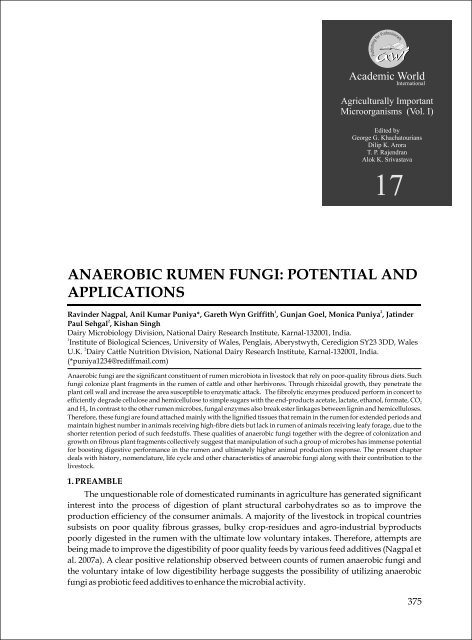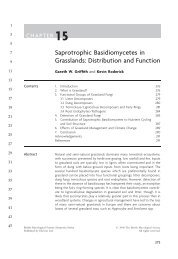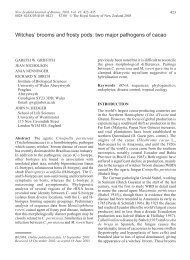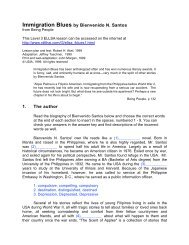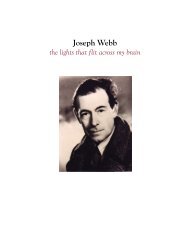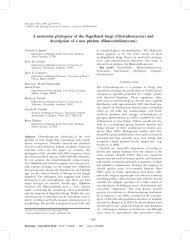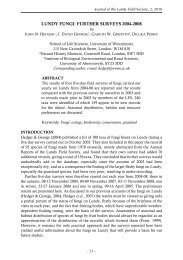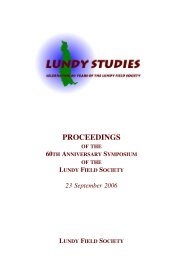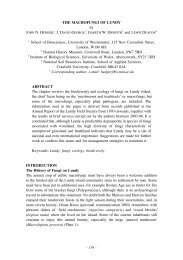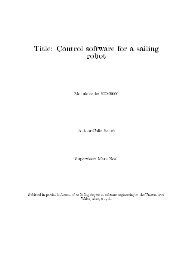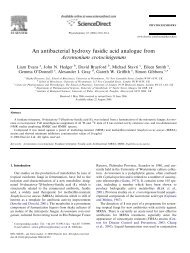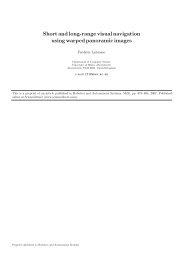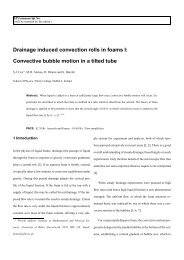Anaerobic rumen fungi
Anaerobic rumen fungi
Anaerobic rumen fungi
You also want an ePaper? Increase the reach of your titles
YUMPU automatically turns print PDFs into web optimized ePapers that Google loves.
ANAEROBIC RUMEN FUNGI: POTENTIAL AND<br />
APPLICATIONS<br />
1 2<br />
Ravinder Nagpal, Anil Kumar Puniya*, Gareth Wyn Griffith , Gunjan Goel, Monica Puniya , Jatinder<br />
2<br />
Paul Sehgal , Kishan Singh<br />
Dairy Microbiology Division, National Dairy Research Institute, Karnal-132001, India.<br />
1<br />
Institute of Biological Sciences, University of Wales, Penglais, Aberystwyth, Ceredigion SY23 3DD, Wales<br />
2<br />
U.K. Dairy Cattle Nutrition Division, National Dairy Research Institute, Karnal-132001, India.<br />
(*puniya1234@rediffmail.com)<br />
<strong>Anaerobic</strong> <strong>fungi</strong> are the significant constituent of <strong>rumen</strong> microbiota in livestock that rely on poor-quality fibrous diets. Such<br />
<strong>fungi</strong> colonize plant fragments in the <strong>rumen</strong> of cattle and other herbivores. Through rhizoidal growth, they penetrate the<br />
plant cell wall and increase the area susceptible to enzymatic attack. The fibrolytic enzymes produced perform in concert to<br />
efficiently degrade cellulose and hemicellulose to simple sugars with the end-products acetate, lactate, ethanol, formate, CO 2<br />
and H 2.<br />
In contrast to the other <strong>rumen</strong> microbes, fungal enzymes also break ester linkages between lignin and hemicelluloses.<br />
Therefore, these <strong>fungi</strong> are found attached mainly with the lignified tissues that remain in the <strong>rumen</strong> for extended periods and<br />
maintain highest number in animals receiving high-fibre diets but lack in <strong>rumen</strong> of animals receiving leafy forage, due to the<br />
shorter retention period of such feedstuffs. These qualities of anaerobic <strong>fungi</strong> together with the degree of colonization and<br />
growth on fibrous plant fragments collectively suggest that manipulation of such a group of microbes has immense potential<br />
for boosting digestive performance in the <strong>rumen</strong> and ultimately higher animal production response. The present chapter<br />
deals with history, nomenclature, life cycle and other characteristics of anaerobic <strong>fungi</strong> along with their contribution to the<br />
livestock.<br />
1. PREAMBLE<br />
r<br />
o<br />
f<br />
g<br />
n<br />
i<br />
h<br />
s<br />
i<br />
l<br />
b<br />
u<br />
P<br />
P<br />
r<br />
fe s<br />
o s<br />
Academic World<br />
Agriculturally Important<br />
Microorganisms (Vol. I)<br />
Edited by<br />
George G. Khachatourians<br />
Dilip K. Arora<br />
T. P. Rajendran<br />
Alok K. Srivastava<br />
i<br />
o<br />
n<br />
a<br />
ls<br />
17<br />
International<br />
The unquestionable role of domesticated ruminants in agriculture has generated significant<br />
interest into the process of digestion of plant structural carbohydrates so as to improve the<br />
production efficiency of the consumer animals. A majority of the livestock in tropical countries<br />
subsists on poor quality fibrous grasses, bulky crop-residues and agro-industrial byproducts<br />
poorly digested in the <strong>rumen</strong> with the ultimate low voluntary intakes. Therefore, attempts are<br />
being made to improve the digestibility of poor quality feeds by various feed additives (Nagpal et<br />
al. 2007a). A clear positive relationship observed between counts of <strong>rumen</strong> anaerobic <strong>fungi</strong> and<br />
the voluntary intake of low digestibility herbage suggests the possibility of utilizing anaerobic<br />
<strong>fungi</strong> as probiotic feed additives to enhance the microbial activity.<br />
375
Agriculturally Important Microorganisms Vol. II<br />
Rumen anaerobic <strong>fungi</strong> actively colonize plant cell walls and account for up to 8-12% of the<br />
microbial biomass in <strong>rumen</strong> (Rezaeian et al. 2004). Prior to their discovery, it was assumed that<br />
only <strong>rumen</strong> anaerobic bacteria and protozoa were involved in hydrolysis of plant biomass. But<br />
now, it is well established that these ruminal <strong>fungi</strong> effectively take part in fibre digestion in<br />
ruminants (Dey et al. 2004, Lee et al. 2004). The rhizoids of their vegetative thalli penetrate deep<br />
into plant tissues better than bacteria and protozoa, and thus achieve access to plant materials<br />
otherwise unavailable to other <strong>rumen</strong> microorganisms. This infiltration leads to a more rapid<br />
degradation of forage entering the <strong>rumen</strong> (Orpin and Joblin, 1988; Nagpal et al. 2007b). These<br />
<strong>fungi</strong> secrete high levels of very active fibre-degrading enzymes (cellulases, hemicellulases,<br />
xylanases, avicelases, glycosidases etc.) found to be associated with rhizomycelia (Williams et al.<br />
1994; Lee et al. 2001).<br />
2. HISTORICAL MILIEU<br />
The ruminal anaerobic <strong>fungi</strong>, reported as early as 1910, were thought to be flagellate protozoa<br />
(Liebetanz, 1910; Braune, 1913) and placed in the genera Callimastix, Sphaeromonas and Oikomonas.<br />
These flagellates were recognized as <strong>fungi</strong> for the first time in the 1970s (Orpin, 1975) with the first<br />
named species Neocallimastix frontalis. The flagellate zoospores encyst and germinate on ingested<br />
forage with radiating rhizoids that produce a single zoosporangium. In terms of lifecycle and<br />
morphology, N. frontalis is similar to members of Chytridiomycota and its fungal affinities are<br />
confirmed by chitin in the cell wall (Orpin, 1975); though uniquely among the <strong>fungi</strong> it is an<br />
obligate anaerobe. About twenty different species of anaerobic <strong>rumen</strong> <strong>fungi</strong> have been reported<br />
in various ruminant and hindgut-fermenting mammals. It is established that removal of these<br />
<strong>fungi</strong> from the <strong>rumen</strong> results in a significant diminution in in-vitro gas production and<br />
degradation of fibrous feeds, signifying a vital role such <strong>fungi</strong> play in fibre degradation (Lee et al.<br />
2004). The enzyme profiles of various <strong>fungi</strong> studied indicated secretion of a wide range of lignocellulolytic<br />
enzymes. Scanning electron microscopic studies ascertained that these <strong>fungi</strong><br />
preferably attach to most lignified tissues of plant feed (Akin, 1987). Hence, fibre-based diets<br />
stimulate their proliferation in the <strong>rumen</strong> compared to diets rich in easily fermentable<br />
carbohydrates (Paul et al. 2003). Pelleted diets generally have a shorter transit time through the<br />
gastro-intestinal tract and therefore do not support good anaerobic growth of <strong>rumen</strong> <strong>fungi</strong> in-situ.<br />
High soluble sugar content inhibits germination of fungal zoospores on plant tissues (Roger et al.<br />
1992), and this might be due to lowered pH of <strong>rumen</strong> liquor (Orpin, 1977).<br />
3. TAXONOMIC STATUS<br />
<strong>Anaerobic</strong> zoospore-producing <strong>fungi</strong> are very recently assigned to Chytridiomycota, a basal<br />
group within kingdom Fungi and subdivided into five orders i.e., Blastocladiales,<br />
Monoblepharidiales, Chytridales, Spizellomycetales and Neocallimastigales (Barr, 1990). Based<br />
on the ultrastructural characteristics of zoospores, anaerobic <strong>fungi</strong> were originally placed in the<br />
order Spizellomycetales (Barr, 1980; Barr and Desaulniers, 1988) but later transferred to a separate<br />
order (Neocallimastigales) by Li et al (1993). The precise relatedness of the Neocallimastigales to<br />
other chytrid <strong>fungi</strong> is at present unclear since they possess a number of features not common with<br />
other chytrid taxa (hydrogenosomes, polyflagellate zoospores, distinctive flagellar attachment;<br />
Barr, 1990; James et al., 2000), and are distinctive in other respects too (e.g. very high AT [ca. 70%]<br />
DNA base ratio; Brownlee, 1989). The recent international collaborative effort (AFTOL project: All<br />
Fungus Tree Of Life; http://aftol.org/) to establish a multiple gene genealogy for kingdom Fungi<br />
found Chytridiomycota to be polyphyletic (with loss of flagellate zoospores on several occasions)<br />
but confirmed anaerobic <strong>fungi</strong> basal to the 'core' chytrid clade (James et al., 2006a; b). On the basis<br />
376
ANAEROBIC RUMEN FUNGI<br />
of many distinctive features of anaerobic <strong>fungi</strong> relative to other chytrids, these may be assigned to<br />
a new phylum Neocallimastigomycota phylum nov. (MycoBank no.: MB 501279), containing a single<br />
class Neocallimastigomycetes nov. (MycoBank no.: MB 501280) (Hibbett et al., 2007).<br />
Gold et al (1988) recommended subdivision of anaerobic <strong>fungi</strong> into three genera<br />
Neocallimastix, Piromyces (formerly Piromonas) and Caecomyces (formerly Sphaeromonas).<br />
However, three other genera with more complex growth morphology have subsequently been<br />
discovered i.e. Orpinomyces (Barr et al. 1989), Anaeromyces (Breton et al. 1990) and Cyllamyces<br />
(Ozkose et al. 2001). In all such genera, multiple sporangia are formed in Orpinomyces and<br />
Anaeromyces on a more extensive polycentric thallus. Cyllamyces, like Caecomyces, forms bulbous<br />
holdfasts (which can cause rupture of plant tissues; Joblin, 1989) rather than a rhizoidal system<br />
with up to 12 sporangia formed on branched sporangiophores. Thus, the six genera can be<br />
divided into three groups based on colony morphology (monocentric, polycentric or bulbous).<br />
However, it is likely that zoospore flagellation represents a more fundamental division within the<br />
anaerobic <strong>fungi</strong> with Neocallimastix and Orpinomyces having multiflagellate (5-20 flagella)<br />
zoospores while other genera being uniflagellate. Table 1 represents the classification and<br />
different morphological characteristics of ruminal anaerobic <strong>fungi</strong>.<br />
Kingdom:<br />
Phylum:<br />
Class:<br />
Order:<br />
Genera:<br />
Table 1. Classification and morphological characteristics of anaerobic<br />
<strong>fungi</strong> (after Barr, 1990; James et al., 2000; Hibbett et al., 2007).<br />
A.<br />
B.<br />
Fungi<br />
Neocallimastigomycota<br />
Neocallimastigomycetes<br />
Neocallimastigales<br />
Monocentric: Neocallimastix: zoospore with 4 - 20 flagella;<br />
thallus with filamentous branching rhizoids; Piromyces:<br />
zoospore with 1 - 4 flagella and thallus with filamentous<br />
branching rhizoids, and<br />
Polycentric: Orpinomyces: multiflagellate zoospores;<br />
Anaeromyces: zoospore with single flagellum; Cyllamyces:<br />
zoospore with 1 - 2 flagella with thalloid branched<br />
sporangiophore.<br />
Bulbous: Caecomyces: zoospores with 1 - 2 flagella; thallus with<br />
globular rhizoid; Cyllamyces: zoospore with 1 - 2 flagella,<br />
thalloid branched sporangiophores<br />
Presently, 18 species of anaerobic <strong>fungi</strong> have been identified and described (Table 2). No<br />
anaerobic <strong>fungi</strong> have hitherto, been reported to have a sexual stage.<br />
4. THE LIFE CYCLE<br />
The life cycle of monocentric <strong>fungi</strong> is asexual and shifts between a motile, zoosporic and a<br />
vegetative, zoosporangial stage (Figure 1). The flagellate zoospores move by chemotaxis to<br />
colonize the fibre material (Orpin and Bountiff, 1978; Munn et al. 1988). N. patriciarum zoospores<br />
show chemotaxis towards several carbohydrates as receptors e.g. glucose, mannose, sorbitol and<br />
sucrose (Orpin and Bountiff, 1978), and move across the plant surface, presumably to stumble on<br />
the right location for encystment. After release, these get encysted and germinate exogenously to<br />
form a germ tube from which the rhizoids emerge (Orpin, 1977). The cell mass develops into a<br />
377
Agriculturally Important Microorganisms Vol. II<br />
378<br />
Table 2. Classification of anaerobic <strong>fungi</strong> (after Cabe, 1998; Ozkose et al. 2001; Harhangi, 2002).<br />
Genus/ Species Source(s) Reference(s)<br />
Caecomyces:<br />
C. communis; C. equi<br />
Piromyces:<br />
P. communis ; P. mae; P.<br />
dumbonica ; P. rhizinflata; P.<br />
minutus; P. spiralis; P. citronii<br />
Neocallimastix:<br />
N. frontalis ; N. patriciarum ;<br />
N. hrleyensis; N. variabilis<br />
Anaeromyces:<br />
A. elegans; A. mucronatus<br />
Orpinomyces:<br />
O. joyonii; O. intercalaris<br />
Sheep; Horse<br />
Sheep; cow;<br />
Horse; Elephant;<br />
Deer; Goat;<br />
Donkey<br />
Sheep; Cow<br />
Cow; Sheep<br />
Sheep; Cow<br />
Gold et al. (1988)<br />
Gold et al. (1988); Julliand et al.<br />
(1998); Li et al. (1990); Breton et al.<br />
(1991); Ho et al. (1993a & b);<br />
Gaillard-Martinie et al. (1995)<br />
Heath et al. (1983); Orpin and<br />
Munn, (1986); Webb and<br />
Theodorou, (1991); Ho et al.<br />
(1993c)<br />
Ho et al. (1993d); Breton et al.<br />
(1990)<br />
Breton et al. (1989); Ho et al.<br />
(1994)<br />
Cyllamyces:<br />
C. aberensis Cow Ozkose et al. (2001)<br />
sporangium and cytokinesis results in uninucleate zoospores to be released to complete the cycle.<br />
From studies on Neocallimastix, it is established that the life cycle lasts about 23-32 hours (Lowe et<br />
al. 1987a), whilst in Cyllamyces aberensis, it is slightly shorter to 18-24 hrs (Ozkose et al. 2001).<br />
Zoospores development from young sporangia may occur within 8 hours after encystment under<br />
appropriate conditions (Orpin, 1977).<br />
Unlike monocentric and bulbous taxa, polycentric <strong>fungi</strong> have less determinate lifecycles and can<br />
differentiate multiple sporangia over periods of several days. Nuclei are visible within rhizoids<br />
but it is unclear to what extent these resemble hyphae of higher <strong>fungi</strong> (Ho and Bauchop, 1991).<br />
Zoosporogenesis is asynchronous as in other taxa and in culture, zoospores are often very rare<br />
(Phillips, 1989 Fliegerova et al., 2004).<br />
Fig.1. Life cycle of anaerobic <strong>fungi</strong> (Source: Teunissen and Op den Camp, 1993; Harhangi, 2002).
5. DISTRIBUTION IN NATURE<br />
<strong>Anaerobic</strong> <strong>fungi</strong> have been reported in all geographic regions of the world, being ubiquitous<br />
among fore-gut fermenters and ruminants such as cattle, buffalo, goat (Ho et al. 1993a; 1993c;<br />
Singhal, 2000; Thareja et al. 2006), red deer, impala (Bauchop, 1979) and wild Bluebull (Boselaphus<br />
tragocamelus) (Paul et al. 2004; Tripathi et al. 2007a) as well as marsupials including kangaroo,<br />
wallaroo and swamp wallaby (Breton et al. 1989). These <strong>fungi</strong> have also been isolated from faecal<br />
samples of the horse, zebra, donkey, rhinoceros and Indian elephant (Bauchop, 1983; Breton et al.<br />
1990; Li et al. 1990; Orpin, 1994; Theodorou et al. 1994), all being hindgut fermenters. Therefore,<br />
these <strong>fungi</strong> appear to be a standard constituent of the gut microflora in many herbivores fed on a<br />
highly fibrous diet.<br />
6. METABOLISM AND PHYSIOLOGY<br />
<strong>Anaerobic</strong> <strong>fungi</strong> derive energy by anaerobic fermentation of carbohydrates (Trinci et al. 1994). A<br />
large number of poly-, oligo-, and monosaccharides including glucose, cellobiose, fructose,<br />
maltose, sucrose and xylose, support their growth (Orpin, 1975, 1976; Mountfort and Asher, 1983;<br />
Phillips and Gordon, 1988). <strong>Anaerobic</strong> <strong>fungi</strong> follow a mixed-acid fermentation profile similar to<br />
enterobacteria such as E. coli with the conversion of hexose to acetate, formate, lactate, succinate,<br />
ethanol, CO 2 and H 2 (Borneman et al. 1989, Trinci et al. 1994). These products may fluctuate among<br />
different genera i.e. high malate and lactate by Anaeromyces spp. compared to Orpinomyces<br />
(Phillips and Gordon, 1988). Table 3 shows the outline of cellulose fermentation by N. frontalis:<br />
Table 3. Fermentation of cellulose by N. frontalis (Bauchop and Mountfort, 1981).<br />
Fermentation product mol/ 100 mol hexose<br />
Acetate<br />
72.7<br />
Lactate<br />
67.0<br />
Ethanol<br />
37.4<br />
Formate<br />
83.1<br />
Carbon dioxide<br />
37.6<br />
Hydrogen<br />
35.3<br />
Methane 0.0<br />
ANAEROBIC RUMEN FUNGI<br />
<strong>Anaerobic</strong> <strong>fungi</strong> lack mitochondria, cytochromes and other biochemical features of the<br />
oxidative phosphorylation pathway. In cytosol, all major enzymes required for glycolysis<br />
through the Embden-Meyerhof-Parnas pathway are present while glucose-6-phosphate<br />
dehydrogenase and the other enzymes of Entner-Dodouroff pathway are absent (Yarlett et al.<br />
1986; O'Fallon et al. 1991; Marvin-Sikkema et al. 1993). The group possesses organelles<br />
(hydrogenosomes) for a major part of anaerobic energy metabolism (Muller, 1993; Trinci et al.<br />
1994; Benchimol et al. 1996). Hydrogenosomes are spherical double-membrane bound redox<br />
organelles (0.2 – 1 µm), and have been reported in phylogenetically distant amitochondriate<br />
eukaryotes that inhabit anaerobic or microaerophilic environments (Muller, 1993).<br />
7. TRANSFER AND SURVIVAL BETWEEN DIFFERENT HOSTS<br />
<strong>Anaerobic</strong> <strong>fungi</strong> can be isolated from alimentary tracts of ruminants (Davies et al. 1990, 1993)<br />
and propagules survive in air-dried faeces up to 10 months (Milne et al. 1989; Theodorou et al.<br />
1990; McGranaghan et al. 1999). There have been attempts to identify putative aero-tolerant<br />
resting structures (Wubah et al., 1991b; Nielsen et al., 1995; Richardson et al., 1998), though only in<br />
a single unnamed Anaeromyces species have spores been unequivocally identified (Ozkose, 2001;<br />
379
Agriculturally Important Microorganisms Vol. II<br />
Brookman et al., 2000b). In the latter case, <strong>fungi</strong> could be resuscitated from pure cultures after<br />
incubation at 39ºC for up to 11 months (anaerobic <strong>fungi</strong>, however, do not survive beyond 10 days<br />
without subculturing) (Ozkose, 2001). Furthermore, thick-walled, elongate and septate spores<br />
are readily visible in these cultures. The ability of anaerobic <strong>fungi</strong> to form spores and possibly,<br />
other resting structures in large part explain why they can be transferred so readily between host<br />
animals, and far more easily than <strong>rumen</strong> protozoans which require direct animal contact<br />
(Williams, 1986). In fact, during an early study on <strong>rumen</strong> protozoans, Becker and Hsiung (1929)<br />
prevented re-infection by "Callimastix" [sic] of isolated defaunated goats for more than a few<br />
weeks (even if the feed was sterilized). As is the case with <strong>rumen</strong> protozoans, transfer of<br />
anaerobic <strong>fungi</strong> from mother to neonates can also occur by direct contact with saliva during<br />
grooming and licking, or by coprophagy (Lowe et al. 1987b; Milne et al. 1989). In sheep, anaerobic<br />
fungal populations are established by 8-10 days of birth (Fonty et al. 1987). As ruminal <strong>fungi</strong> can<br />
utilize lactose as a carbon and energy source, their population, along with other microorganisms,<br />
gets accumulated and develops in the under developed <strong>rumen</strong> of young lambs fed on milk; and<br />
subsequently stabilizes with the development of <strong>rumen</strong> as the animal starts consuming fibrous<br />
diet (Fonty et al. 1987; Fonty and Grenet, 1994).<br />
Fungal transfer in nature is not only inter-ruminant, but also from non-ruminant to ruminant<br />
as these can also be transmitted by aerosols and dried faeces (Orpin, 1989; Dehority and Orpin,<br />
1996). Interspecies transfer has been demonstrated by the establishment in sheep of high ruminal<br />
populations of Piromyces sp. isolated from horse faeces and also a strain of Neocallimastix from the<br />
reindeer <strong>rumen</strong> (Orpin, 1989). Orpinomyces sp. and Piromyces sp., from cow's <strong>rumen</strong> and faeces of<br />
wild blue bull, respectively, establish in the <strong>rumen</strong> after administrating to male buffalo calves fed<br />
with wheat straw based diets (Tripathi et al. 2007b). As with the <strong>rumen</strong> protozoans, where<br />
evidence of host specificity is equivocal (Williams, 1986), the various anaerobic fungal taxa show<br />
little geographic structure with diet having a far greater effect on fungal population than the host.<br />
However, Phillips and Gordon (1988) reported that polycentric taxa could not be isolated from<br />
sheep in Australia.<br />
8. FIBRE DEGRADATION POTENTIAL<br />
The role of <strong>rumen</strong> <strong>fungi</strong> in the degradation of plant fibre has been examined extensively<br />
(Theodorou et al. 1989; Samanta et al. 2001; Paul et al. 2004; Dey et al. 2004; Lee et al. 2004; Thareja<br />
et al. 2006; Dayanand et al. 2007; Tripathi et al. 2007a, b). The rhizoids or bulbous holdfasts of<br />
vegetative thalli are better at penetrating plant tissue than are bacteria and protozoa, so they gain<br />
access to the plant material not accessible to other <strong>rumen</strong> microorganisms (Orpin and Joblin,<br />
1988). Bauchop and Mountfort (1981) suggested that such penetrations lead to a faster and<br />
complete degradation of forage entering the <strong>rumen</strong>. Degradation of lignified plant cell walls is an<br />
important characteristic of <strong>rumen</strong> <strong>fungi</strong> (Mountfort et al. 1982; Akin and Benner, 1988). Zoospores<br />
of many species colonize the lignified tissues preferentially and establish colonies localized on<br />
sclerenchyma and xylem cells. Early observations indicated that lignified cell walls were<br />
degraded to a greater extent by <strong>rumen</strong> <strong>fungi</strong> than by <strong>rumen</strong> bacteria and protozoa. Experiments<br />
14<br />
with specifically labeled C polysaccharides or lignin indicated that the <strong>rumen</strong> <strong>fungi</strong> solubilize<br />
phenolics and degrade lignocellulose, although cannot consume the lignin moiety (Gordon and<br />
Phillips, 1989).<br />
<strong>Anaerobic</strong> <strong>fungi</strong> penetrate the cuticle, the rigid structural barrier on the outside of the plant<br />
epidermis. These <strong>fungi</strong> often enter the leaf interior through stomata in the epidermal layer (Akin<br />
et al. 1983) giving these <strong>fungi</strong> an advantage in degrading plant fibre through substantial increase<br />
380
ANAEROBIC RUMEN FUNGI<br />
in the area available for infection. Rumen <strong>fungi</strong> also show protease activity that may have role in<br />
degradation, because the plant structural proteins increase the integrity of plant cell wall (Wallace<br />
and Joblin, 1985). Species of Piromyces, Neocallimastix, Orpinomyces and Anaeromyces degrade fibre<br />
to a substantial degree. Caecomyces species degrade fibres but lesser than other genera (Gordon,<br />
1990), perhaps because of the lack of an extensive rhizoidal system. In Bermuda grass (Cynodon<br />
dactylon), stems and leaves harbour Neocallimastix and Orpinomyces species to degrade the plant<br />
material most effectively by weakening the textural strength of the residue (Akin et al. 1990).<br />
These findings suggest that the ability to degrade fibre varies among fungal genera, and that<br />
plants differ in their support for fungal growth. The greater ability of <strong>rumen</strong> <strong>fungi</strong>, compared to<br />
<strong>rumen</strong> bacteria, to weaken forage fibres may be vital to enhancing its utilization by the host<br />
animal (Borneman and Akin, 1990).<br />
Ito et al. (1994) studied sheep <strong>rumen</strong> <strong>fungi</strong> for degradability and digestibility of rice straw<br />
and observed significant decrease in lignin residue that in turn increased digestibility of the feed.<br />
Studies by Manikumar et al. (2002) and Dey et al. (2004) indicated increased in vitro dry matter<br />
digestibility, and decreased cell wall contents of straws by different anaerobic <strong>fungi</strong> viz,<br />
Orpinomyces, Piromyces and Anaeromyces relative to untreated controls. Also, the molar yield of<br />
acetate increased with simultaneous decrease for propionate and butyrate. In a subsequent<br />
report, hydrolysis of rice and wheat straw by Orpinomyces sp. (C14) was superior to that of<br />
Piromyces or Anaeromyces (Manikumar et al. 2003).<br />
Gordon and Phillips (1998) reported a 7-12% increase in voluntary intake of straw based diet<br />
by sheep dosed with monocentric <strong>fungi</strong> from other herbivores. In contrast, no such effect on feed<br />
intake was observed in crossbred calves dosed with polycentric Orpinomyces sp. However, the<br />
growth rate and nutrient digestion in cow calves improved in the fungus-administered sets.<br />
There was also a two and a half fold increase in the fungal count in <strong>rumen</strong> liquor of fungusadministered<br />
animals (Dey et al. 2004).<br />
Lee et al. (2000, 2004) studied the effect of administration of Orpinomyces strain KNGF2 from<br />
Korean native goats, or their enzymes on the extent of ruminal fermentation, microbial<br />
population, enzyme activities and nutrient digestion in sheep <strong>rumen</strong>. There was a 2-3 fold<br />
increase in cellulolytic bacterial count in case of anaerobic fungal treatment of silage based ratios<br />
compared to the control.<br />
9. FIBROLYTIC ENZYMES<br />
The ability of ruminants in digesting the plant structural polysaccharides, primarily cellulose<br />
and hemicelluloses, depends on the capacity of microorganisms inhabiting <strong>rumen</strong>, and <strong>rumen</strong><br />
<strong>fungi</strong> play a major role in degradation of lignified plant tissues (Akin and Benner, 1988). For plant<br />
cell wall degradation, such anaerobic <strong>fungi</strong> produce a wide range of hydrolytic enzymes,<br />
cellulases (Barichievich and Calza, 1990; Yanke et al. 1993), hemicellulases (Mountfort and Asher,<br />
1989), proteases (Michel et al. 1993), amylases, amyloglycosidases (Paul et al. 2004), feruloyl and<br />
p-coumaryl esterases (Borneman et al. 1992), various disaccharidases (Chen et al. 1994),<br />
pectinases (Gordon and Phillips, 1992) and exonucleases (Cabe, 1998).<br />
Three enzymes viz, endo-1,4--glucanase, exo-1,4--glucanase and -glucosidase act<br />
synergistically for efficient cellulose hydrolysis. These enzymes often bind to the substrate prior<br />
to hydrolysis, but they may also bind to other plant cell wall polymers such as xylan (Gilkes et al.<br />
1991). Aryl esterases, viz. p-coumaroyl esterases and feruloyl esterases are other important<br />
enzymes that hydrolyze the ester linkages between hemicellulose and lignin in plant cell walls,<br />
381
Agriculturally Important Microorganisms Vol. II<br />
and thus separating hemicelluloses and cellulose from lignin (Borneman and Akin, 1990) and<br />
render them accessible to hemicellulases and cellulases. Thus, through esterases, anaerobic <strong>fungi</strong><br />
play a more important role over bacteria in separating the lignin-polysaccharide linkages in the<br />
plant particles by extensive rhizoidal elongation, and are thus ahead of bacteria. N. patriciarum<br />
solubilized lignin (up to 34%) in sorghum (McSweeney et al. 1994). Unlike <strong>rumen</strong> cellulolytic<br />
bacteria, <strong>rumen</strong> <strong>fungi</strong> also have proteases that facilitate penetration of the plant proteinaceous<br />
components by fungal rhizoids (Engels and Brice, 1985).<br />
Most fibrolytic enzymes have been found associated with rhizomycelium while some<br />
secreted into the surroundings (Gordon and Phillips, 1992; Williams et al. 1994). The activities of<br />
these enzymes are common to both the zoosporic and vegetative stages as well as in the cell-free<br />
spent culture fluid (Williams and Orpin, 1987); but depend on the stage of the life cycle (Martin<br />
and Nisbet, 1992; Lee et al. 2001). A few fibrolytic enzymes are constitutive, and regulated by the<br />
presence of soluble sugars (Mountfort and Asher, 1983, 1985, 1989), e.g. production of cellulase<br />
repressed by glucose (Mountfort and Asher, 1985). Growth conditions greatly influence enzyme<br />
production as the level of fibrolytic enzymes was 3-fold in a stirred fermenter compared to static<br />
batch cultures (Morgavi et al. 1994; Paul et al. 2003).<br />
Because of the ability of cellulases to rapidly attack crystalline cellulose, there has been<br />
considerable interest in the fibre degrading enzymes of anaerobic <strong>fungi</strong> (Teunissen et al. 1993).<br />
Wilson and Wood (1992) reported that isolates of Neocallimastix and Piromyces were the most<br />
rapid degraders of crystalline cellulose. The weakening of tissues by fungal enzymes may<br />
accelerate digestion, and thus making rumination more effective in reducing particle size and<br />
increasing protozoal and bacterial digestion in the <strong>rumen</strong>.<br />
10. MICROECOLOGY IN THE RUMEN<br />
The interactions of anaerobic <strong>fungi</strong> with other <strong>rumen</strong> microbes can be positive, negative or<br />
neutral, depending on the microbial group involved and the type of substrate used. Since, <strong>rumen</strong><br />
<strong>fungi</strong> produce appreciable amounts of H 2; they can interact with H 2 utilizers which in turn alter<br />
their metabolite production. Methanogens are the principal H 2 utilizers in <strong>rumen</strong>; and stable<br />
cocultures of <strong>fungi</strong> and methanogens have been established in vitro (Fonty and Joblin, 1991; Orpin<br />
and Joblin, 1997). Such cocultures resulted in increased fungal biomass (Bernalier et al. 1989) and<br />
also an increase in the rate and extent of cellulose degradation (Wood et al. 1986; Joblin et al. 1989;<br />
Bernalier et al. 1991). Interspecies H 2 transfer between the cellulolytic H2-producing anaerobic<br />
<strong>fungi</strong> and methanogens resulted in increased CO 2 and acetate formation but decreased ethanol<br />
and lactate output (Bauchop and Mountfort, 1981; Mountfort et al. 1982). The presence of<br />
Methanobacterium arboriphilus, Methanobacterium bryantii, or Methanobrevibacter smithii also<br />
increased (5 to 10%) the level of cellulose fermentation by anaerobic <strong>fungi</strong> (Marvin-Sikkema et al.<br />
1990). By contrast, cellulose degradation and lactate production by N. frontalis decreased in<br />
cocultures with non-lactate utilizing Selenomonas ruminantium, the sugar fermenting, H 2<br />
consuming <strong>rumen</strong> bacterium, thus indicating interspecies hydrogen transfer (Richardson and<br />
Stewart, 1990).<br />
The <strong>fungi</strong> are involved in cross-feeding in that they release free sugars, which in addition to<br />
several of their normal metabolites (except acetate), serve as energy sources for other bacterial<br />
species. The <strong>fungi</strong> themselves may also depend on the bacteria for supply of B vitamins, heme and<br />
amino acids, as the nutritional requirement (Williams et al. 1994). On the other hand, coculture of<br />
anaerobic <strong>fungi</strong> with <strong>rumen</strong> bacteria inhibits the cellulolytic activity (Bernalier et al. 1992; Roger et<br />
382
ANAEROBIC RUMEN FUNGI<br />
al. 1993) and growth (Dehority and Tirabasso, 2000) of the former. Stewart et al. (1992) and<br />
Bernalier et al. (1993) reported an extracellular, thermo-labile protein produced by ruminococci,<br />
which inhibits fungal cellulase activity. Dehority and Tirabasso (1993) also reported that mixed<br />
<strong>rumen</strong> bacteria produce a heat stable compound in vitro, which markedly inhibits growth of<br />
<strong>rumen</strong> <strong>fungi</strong>.<br />
Since chitin is the main structural component of fungal cell wall, their growth is likely to be<br />
inhibited by <strong>rumen</strong> chitinolytic microorganisms such as Clostridium sp. Co-culturing of the<br />
anaerobic <strong>fungi</strong> with chitinolytic Clostridium tertium significantly reduced solubilization of<br />
crystalline cellulose, production of short-chain fatty acids and release of endoglucanase<br />
(Hodrova et al. 1995), suggesting the role of chitinolytic bacteria in controlling fungal activities in<br />
vivo. Thus, <strong>rumen</strong> <strong>fungi</strong> do not appear to attain their optimal fibre-degrading potential in <strong>rumen</strong><br />
due to the inhibition by some bacteria. Small sized fungal zoospores are likely to be a prey for<br />
protozoa. Co-incubation of protozoa with <strong>fungi</strong> revealed that protozoa are able to ingest and<br />
digest <strong>fungi</strong> (Morgavi et al. 1994). The fungal growth and cellulolysis is negatively affected by<br />
<strong>rumen</strong> protozoa, possibly because of protozoal predation on zoospores.<br />
11. RESPONSE TO DIVERSE DIETS<br />
The forage rich diets such as hay and silage, with a long ruminal transit time, consistently<br />
result in high population density of anaerobic <strong>fungi</strong> (Fonty and Grenet, 1994). The addition of<br />
maize to sorghum silage enhanced degradation by anaerobic <strong>fungi</strong> (Akin and Windham, 1989).<br />
Also, the addition of grain concentrate to the hay diet significantly increased the count of fungal<br />
zoospores in sheep <strong>rumen</strong> (Faichney et al. 1997). In sheep consuming appreciable amounts of<br />
fibres, a large number of sporangia are found attached to stem fragments before morning feeding<br />
(Bauchop, 1979). Fungal populations were also stimulated to a much greater extent with alfalfa<br />
diet than with coastal Bermuda grass (Windham and Akin, 1984).<br />
By contrast, diet rich in soluble carbohydrates (i.e. young pasture, whey and fodder beet)<br />
result in a relatively low population density of anaerobic <strong>fungi</strong> (Grenet et al. 1989). Silage diet<br />
from sorghum or maize reduced the numbers of anaerobic <strong>fungi</strong> in the <strong>rumen</strong> (Akin et al. 1988).<br />
Similarly, rye grass at the leafy stage, was also found unfavorable for <strong>fungi</strong> (Grenet et al. 1989).<br />
<strong>Anaerobic</strong> <strong>fungi</strong> are generally adversely affected by the addition of lipid to the diet (Jenkins,<br />
1993). Feeding a supplement of sunflower, cottonseed or rapeseed oil meal to animals also<br />
depressed fungal population in the <strong>rumen</strong> (Elliott et al. 1987; Fonty and Grenet, 1994).<br />
12. CONTRIBUTION OF FUNGI TO HOST NUTRITION<br />
Various reports suggest a positive correlation between anaerobic <strong>fungi</strong> and voluntary intake<br />
of low digestible herbage diet (Akin et al. 1983; Weston et al. 1988; Gordon and Phillips, 1993). This<br />
association is an outcome of fungal attack on lignified tissues (Akin, 1987; Akin and Borneman,<br />
1990) combined with the weakening of more recalcitrant plant components (Akin et al. 1983,<br />
1989). Soft feed fragments in the <strong>rumen</strong> may be anticipated to lead to less effort by the animal in<br />
eating and ruminating. A positive correlation between populations of <strong>rumen</strong> anaerobic <strong>fungi</strong> and<br />
rumination efficiency in sheep fed a wheat straw diet has been reported by Weston et al. (1988).<br />
Therefore, anaerobic <strong>fungi</strong> apparently facilitate the physical disruption during rumination of the<br />
fibrous particles of poor-quality feed leading to a lower residence of such particles in the <strong>rumen</strong>.<br />
The intake of forage by early weaned calves was 35% higher in calves dosed with Neocallimastix<br />
sp. (Theodorou et al. 1990), and the dosing of fungus-free sheep with Neocallimastix sp. resulted in<br />
a 40% increased intake of a straw-based diet (Gordon and Phillips, 1993).<br />
383
Agriculturally Important Microorganisms Vol. II<br />
These <strong>fungi</strong> also supply protein to the host through the action of proteolytic enzymes and<br />
also as a proportion of the microbial protein synthesized in the <strong>rumen</strong> that passes to abomasum<br />
and intestines for digestion and absorption (Gordon and Phillips, 1998). Kemp et al. (1985), Gulati<br />
et al. (1989) and Onoda et al. (1993) reported that fungal cells are composed of proteins with a well-<br />
balanced combination of amino acids which were highly accessible to and digestible by the<br />
ruminant; and a high proportion of fungal protein is digested and absorbed in the intestines of<br />
sheep with higher digestibility compared to ruminal bacteria (Gulati et al. 1990). Moreover, the<br />
advent of dependable measurements of fungal biomass in ruminant digesta has shown that in<br />
sheep fed with either hay or grain diets, anaerobic <strong>fungi</strong> averaged 2.4% of the microbial nitrogen<br />
in ruminant digesta (Faichney et al. 1997). However, the contribution of anaerobic <strong>fungi</strong> towards<br />
supply of microbial proteins to the animal was minor as these averaged 1.6% of the microbial<br />
nitrogen in digesta flowing to duodenum. Yet, this microbial protein was of high quality and<br />
voluntarily available to animal. Therefore, if the biomass of anaerobic <strong>fungi</strong> in the <strong>rumen</strong> is<br />
enhanced, it is likely that the supply of high-quality microbial protein to host ruminant would be<br />
possible (Gordon and Phillips, 1998).<br />
13. ISOLATION, CHARACTERIZATION AND PERSISTENCE<br />
To culture the <strong>rumen</strong> anaerobic <strong>fungi</strong>, one of the methods involves overlaying the partially<br />
molten agar with filtered <strong>rumen</strong> fluid and incubation at 39°C (48 hrs) as by this time, zoospores<br />
settle and produce individual thalli to yield pure cultures (Orpin, 1975). Lowe et al. (1985)<br />
suggested a plate culture technique to isolate <strong>rumen</strong> <strong>fungi</strong> from <strong>rumen</strong> digesta of sheep and cattle.<br />
The roll-bottle method of Joblin (1981) involves inoculating a dilution series of molten agar<br />
medium with filtered <strong>rumen</strong> fluid. After a period of incubation, axenic cultures could be obtained<br />
from the individual colonies produced. Antibiotics penicillin, streptomycin, neomycin and<br />
chloramphenicol can be added to the isolation media to suppress bacterial growth (Wubah et al.<br />
1991a). It is difficult to maintain these <strong>fungi</strong> as they require an oxygen-free atmosphere. Hence,<br />
the cultures are to be maintained under CO atmosphere during growth.<br />
2<br />
The paucity of morphological features presents a problem regarding the taxonomy of<br />
anaerobic <strong>fungi</strong>. While examining plant material from the digestive tract, <strong>fungi</strong> often appear as<br />
the complex cluster and this makes the classification even up to genus level difficult. At a time<br />
when there is little disagreement as to the status of the six genera, subgeneric classification is<br />
problematic since difficulties associated with exchange and long-term maintenance of cultures<br />
impeded direct morphological and physiological comparisons among isolates. With the advent of<br />
molecular taxonomy, it is hoped that DNA sequence comparisons and phylogenetic<br />
reconstruction will elucidate the relatedness of the various taxa. Indeed, a number of molecular<br />
phylogenetic papers are on record (Brookman et al. 2000a; Fliegerova et al. 2004; Tuckwell et al.<br />
2 0 0 5 ) , a n d o v e r 1 0 0 n u c l e o t i d e s e q u e n c e s d e p o s i t e d w i t h G e n e b a n k<br />
(http://www.ncbi.nlm.nih.gov).<br />
Majority of the sequences deposited relate to the ribosomal RNA genes widely used in<br />
phylogenetic reconstruction. The small ribosomal (18S) subunit is highly conserved in different<br />
taxa and thus contains little phylogenetically useful information for subgeneric classification (Li<br />
and Heath, 1992). In contrast, the internal transcribed spacer (ITS) regions, widely used for study<br />
of closely related fungal taxa, show a high level of variability (Li and Heath, 1992; Brookman et al.<br />
2000a; Fliegerova et al. 2004), and has been used to differentiate the morphologically similar<br />
monocentric (Neocallimastix, Piromyces) and polycentric (Anaeromyces, Orpinomyces) genera.<br />
Brookman et al. (2000a) also reported that the two multiflagellated taxa (Neocallimastix,<br />
384
ANAEROBIC RUMEN FUNGI<br />
Orpinomyces) were closely related based on the ultrastructure of the zoospores. Unfortunately,<br />
various problems including the presence of divergent ITS sequences within individual isolates<br />
has hampered widespread use of this locus for taxonomic studies (Ozkose, 2001), though PCR<br />
amplification of DNA from environmental samples (<strong>rumen</strong> fluid, digesta etc.) using ITS primers<br />
may prove valuable for ecological studies (Tuckwell et al. 2005).<br />
Counts of individual zoospores and zoosporangia have been used to estimate fungal<br />
populations in vitro (Joblin, 1981) and in vivo (Ushida et al. 1989). Breton et al. (1991) used colonyforming<br />
units per gram dry weight of faeces as the basis for quantifying species of Piromyces. An<br />
endpoint dilution practice, based on the technique of most probable numbers, was developed to<br />
enumerate <strong>rumen</strong> <strong>fungi</strong> as thallus-forming units (Theodorou et al. 1990). The procedure involves<br />
a 10-fold dilution series of sample in an antibiotic-containing basal anaerobic medium. Defined<br />
medium plus 10% clarified <strong>rumen</strong> fluid was used for dilution series, and fungal population<br />
represented as thallus-forming units per gram of dry weight.<br />
An indirect method based on zoospore concentration and life cycle parameters has been used<br />
to quantify <strong>fungi</strong> in the <strong>rumen</strong>. Exploiting the life history parameters and growth kinetics of these<br />
<strong>fungi</strong>, France et al. (1990) proposed a mathematical model of the life cycle in a steady state so that<br />
the population of the particle-attached fungal thalli could be calculated from the concentration of<br />
free-swimming zoospores in <strong>rumen</strong> fluid. The values obtained were reliable for samples from<br />
<strong>rumen</strong> and faeces. However, the inadequate knowledge of the life cycle of anaerobic <strong>fungi</strong> makes<br />
it complicated to evaluate the consistency of this technique.<br />
For long-term maintenance of these <strong>fungi</strong>, cultures are usually stored in liquid nitrogen using<br />
anaerobic glycerol as the cryoprotectant. Pure cultures of anaerobic <strong>fungi</strong> can also be maintained<br />
in a defined medium consisting of cell-free <strong>rumen</strong> fluid, tryptone, yeast extract, a carbon source,<br />
buffer, L-cysteine as the reducing agent, and vitamins (Wubah et al. 1991a). Neocallimastix frontalis<br />
has been maintained in a similar medium but without the yeast extract and <strong>rumen</strong> fluid (Lowe et<br />
al. 1985). For prolonged maintenance in the laboratory, pure cultures of anaerobic <strong>fungi</strong> are<br />
transferred into fresh basal anaerobic medium every 3-4 days. Joblin (1981), however, reported<br />
that cultures could be maintained for several months on plant tissues stored at 39°C without subculturing.<br />
Yarlett et al. (1986) reported cryopreservation of the anaerobic fungus Neocallimastix<br />
patriciarum at -80°C with dimethyl sulphoxide as the cryoprotectant, but the survival rate was<br />
only 40% after one year. However, in a similar study by Sakurada et al. (1995), the survival<br />
reached 80% after one year of storage at -84°C with ethylene glycol and cell-free <strong>rumen</strong> fluid.<br />
14. FUTURE PROSPECTS<br />
Rumen microbiologists have constantly shown curiosity in manipulation of the <strong>rumen</strong><br />
microbial ecosystem to boost feedstuff utilization and improved milk production. It is now a wellestablished<br />
fact that anaerobic <strong>fungi</strong> participate in hydrolysis of plant biomass in ruminants,<br />
based on superior penetration of plant tissues over bacteria or protozoa, and thus leading to an<br />
enhanced degradation of forage in the <strong>rumen</strong>. These <strong>fungi</strong> are well equipped with enzymes<br />
important for <strong>rumen</strong> fermentation, and represent group of dynamic cellulolytic organisms that<br />
explicitly colonize fibrous plant fragments. The properties taken together with perceptible extent<br />
of <strong>rumen</strong> populations in animals on high-fibre diets indicates a significant role of such<br />
heterotrophs in fibre digestion. In addition, <strong>fungi</strong> may bring special changes to plant materials in<br />
the <strong>rumen</strong> with the resultant improved feed intake, body weight gain, enhanced milk output, and<br />
improved animal productivity. As efforts are still in its early stages regarding stimulation of<br />
<strong>rumen</strong> fermentation by anaerobic <strong>fungi</strong>, more studies are imperative to assess the extent of their<br />
385
Agriculturally Important Microorganisms Vol. II<br />
contribution to the ruminal digestive event. However, the development of direct-fed microbials<br />
for improved <strong>rumen</strong> performance is a pre-requisite for sustainable animal production. Therefore,<br />
a substantial potential exists for the manipulation of fungal population and activity in the <strong>rumen</strong><br />
to benefit even from poor quality herbages.<br />
CONCLUSION<br />
In the lack of efficient feed materials, utilization of high fibrous crop-residues and<br />
agricultural by-products along with the tested animal probiotic could be a better alternative over<br />
the existing feeding practices. With the onset of technology for production and administration of<br />
direct-fed microbials, it seems feasible to effectively utilize the poor quality fibrous feeds for<br />
higher productivity of animals. Since, there is considerable disparity among the fungal isolates<br />
from domestic as well as wild animals in their fibre degrading potential; there is immense scope to<br />
isolate efficient fibrolytic fungal strains with elevated levels of fibrolytic enzymes so that they can<br />
be posted in the <strong>rumen</strong> for optimum feed utilization. Therefore, more work is needed to study the<br />
diversity of these <strong>fungi</strong> among domestic and wild ruminants, and to isolate/ select the elite<br />
strains with high fibrolytic activity which can get established in the <strong>rumen</strong> to facilitate digestion of<br />
low grade roughages for enhanced meat/ milk production, as the case may be.<br />
ACKNOWLEDGEMENTS : The authors, especially AKP and GWG wish to thank Indian National Science<br />
Academy, New Delhi and Royal Society, London for supporting the establishment of long-term relations between<br />
Indian and UK counterpart, by providing financial assistance to the former for a short visit to UK under scientists<br />
exchange programme.<br />
REFERENCES<br />
Akin DE (1987). Association of <strong>rumen</strong> <strong>fungi</strong> with various forage grasses. Anim Feed Sci Tech 16: 273-385.<br />
Akin DE and Benner R (1988). Degradation of polysaccharides and lignin by ruminal bacteria and <strong>fungi</strong>. Appl<br />
Environ Microbiol 54: 1117-1125.<br />
Akin DE and Borneman WS (1990). Role of <strong>rumen</strong> <strong>fungi</strong> in fibre degradation. J Dairy Sci 73: 3023-3032.<br />
Akin DE and Windham WR (1989). Influence of diet on <strong>rumen</strong> <strong>fungi</strong>. In: Nolan JA, Leng RA and Demeyer DL (eds).<br />
The roles of protozoa and <strong>fungi</strong> ruminant digestion. Australia: Armidale, pp 75-81.<br />
Akin DE, Borneman WS and Windham WR (1988). Rumen <strong>fungi</strong>: morphological types from Georgia cattle and the<br />
attack on forage cell walls. Biosystems 21: 385-391.<br />
Akin DE, Gordon GLR and Hogan JP (1983). Rumen bacterial and fungal degradation of Digitaria pentzii grown with<br />
or without sulphur. Appl Environ Microbiol 46: 738-748.<br />
Akin DE, Lyon CE, Windham WR and Rigsby LL (1989). Physical degradation of lignified stem tissues by ruminal<br />
<strong>fungi</strong>. Appl Environ Microbiol 55: 611-616.<br />
Akin DE, Rigsby LL, Lyon CE and Windham WR (1990). Relationship of tissue digestion to textural strength in<br />
Bermuda grass and alfalfa stems. Crop Sci 30: 990-993.<br />
Barichievich EM and Calza RE (1990). Supernatant protein and cellulase activities of the anaerobic ruminal fungus<br />
Neocallimastix frontalis EB188. Appl Environ Microbiol 56: 43-48.<br />
Barr DJS (1980). An outline for the reclassification of the Chytridiomycetales, and for a new order, the<br />
Spizellomycetales. Can J Bot 58: 2380-2394.<br />
Barr DJS (1990). Phylum Chytridiomycota. In: Margulis L, Corliss JO, Melkonian M, Chapman DJ. (eds). Handbook of<br />
Protoctista. Boston: Jones & Bartlett, pp 454–466.<br />
Barr DJS and Desaulniers NL (1988). Precise configuration of organisms of the chytrid zoospore. Can J Bot 66: 869-876.<br />
Barr DJS, Kudo H, Jakober KD and Cheng KJ (1989). Morphology and development of <strong>rumen</strong> <strong>fungi</strong>: Neocallimastix sp,<br />
Piromyces communis, and Orpinomyces bovis gen. nov, sp. nov. Can J Bot 67: 2815-2824.<br />
Bauchop T (1979). Rumen anaerobic <strong>fungi</strong> of sheep and cattle. Appl Environ Microbiol 38: 148-158.<br />
Bauchop T (1983). The gut anaerobic <strong>fungi</strong>: colonizers of dietary fibre. In: Wallace G and Bell L (eds). Fibre in human<br />
and animal nutrition. Wellington: Royal Society of New Zealand, pp 143-148.<br />
386
ANAEROBIC RUMEN FUNGI<br />
Bauchop T and Mountfort DO (1981). Cellulose fermentation by a <strong>rumen</strong> anaerobic fungus in both the absence and<br />
presence of <strong>rumen</strong> methanogens. Appl Environ Microbiol 42: 1103-1110.<br />
Becker ER and Hsiung TS (1929). The method by which ruminants acquire their fauna of infusoria, and remarks<br />
concerning experiments on the host specificity of these protozoa. Proc Natl Acad Sci (USA) 15: 684-690.<br />
Benchimol M, Johnson PJ and De Souza W (1996). Morphogenesis of the hydrogenosome: an ultrastructural study.<br />
Biol Cell 87: 197-205.<br />
Bernalier A, Bogaert C, Fonty G and Jouany JP (1989). Effect of ionophore antibiotics on <strong>rumen</strong> anaerobic <strong>fungi</strong>. In:<br />
Nolan JV, Leng RA and Demeyer DI (eds). The roles of protozoa and <strong>fungi</strong> in ruminant digestion. Australia:<br />
Armidale, Penambul Books, pp 273-275.<br />
Bernalier A, Fonty G and Gouet P (1991). Cellulose degradation by two <strong>rumen</strong> anaerobic <strong>fungi</strong> in monoculture or in<br />
coculture with <strong>rumen</strong> bacteria. Anim Feed Sci Tech 32: 131-136.<br />
Bernalier A, Fonty G, Bonnemoy F and Gouet P (1992). Degradation and fermentation of cellulose by the <strong>rumen</strong><br />
anaerobic <strong>fungi</strong> in axenic cultures or in association with cellulolytic bacteria. Curr Microbiol 25: 143-148.<br />
Bernalier A, Fonty G, Bonnemoy F and Gouet P (1993). Inhibition of the cellulolytic activity of Neocallimastix frontalis<br />
by Ruminococcus flavefaciens. J Gen Microbiol 139: 873-880.<br />
Borneman WS and Akin DE (1990). Lignocellulose degradation by <strong>rumen</strong> <strong>fungi</strong> and bacteria: Ultrastructure and cell<br />
wall degrading enzymes. In: Akin DE, Ljungdahl LG, Wilson JR and Harris PJ (eds). Microbial and Plant<br />
Opportunities to Improve Lignocellulose Utilization by Ruminants. New York: Elsevier, pp 325-339.<br />
Borneman WS, Akin DE and Ljungdahl LG (1989). Fermentation products and plant cell wall degrading enzymes<br />
produced by monocentric and polycentric anaerobic <strong>rumen</strong> <strong>fungi</strong>. Appl Environ Microbiol 55: 1066-1073.<br />
Borneman WS, Ljungdahl LG, Hartley RD and Akin DE (1992). Purification and partial characterization of two<br />
feruloyl esterases from the anaerobic fungus Neocallimastix strain MC2. Appl Environ Microbiol 58: 3762-3766.<br />
Braune R (1913). Untersuchungen uber die in Weider Kavermayen Vorkommenden Protozoen. Arch Protistenk 32:<br />
111-170.<br />
Breton A, Bernalier A, Bonnemoy F, Fonty G, Gaillard B and Gouet P (1989). Morphological and metabolic<br />
characterization of a new species of strictly anaerobic <strong>rumen</strong> fungus : Neocallimastix joyonii. FEMS Microbiol<br />
Lett 58: 309-314.<br />
Breton A, Bernalier A, Dusser M, Fonty G, Gaillard-Martinie B and Guillot J (1990). Anaeromyces mucronatus nov. gen,<br />
nov. sp. A new strictly anaerobic <strong>rumen</strong> fungus with polycentric thallus. FEMS Microbiol Lett 70: 177-182.<br />
Breton A, Dusser M, Gaillard-Martinie B, Guillot J, Millet L and Prensier G (1991). Piromyces rhizinflata nov. sp, a<br />
strictly anaerobic fungus from the faeces of the Saharan ass: a morphological, metabolic and ultrastructural<br />
study. FEMS Microbiol Lett 66:1-8.<br />
Brookman JL, Mennim G, Trinci APJ, Theodorou MK and Tuckwell DS (2000a). Identification and characterization of<br />
anaerobic gut <strong>fungi</strong> using molecular methodologies based on ribosomal ITS1 and 18S rRNA. Microbiol 146: 393-<br />
403.<br />
Brookman JL, Ozkose E, Rogers S, Trinci APJ and Theodorou MK (2000b). Identification of spores in the polycentric<br />
anaerobic gut <strong>fungi</strong> which enhance their ability to survive. FEMS Microbiol Ecol 31:261-267.<br />
Brownlee AG (1989). Remarkably AT-rich genomic DNA from the anaerobic fungus Neocallimastix. Nucleic Acids<br />
Res 17:1327-1335.<br />
Cabe TKM (1998). Production of cellulolytic enzymes using immobilized anaerobic <strong>fungi</strong>. PhD dissertation.<br />
University of Western Sydney, Macarthur, Australia.<br />
Chen H, Li X and Ljungdhal LG (1994). Isolation and properties of an extracellular â-glucosidase from the polycentric<br />
<strong>rumen</strong> fungus Orpinomyces sp. strain PC-2. Appl Environ Microbiol 60: 64-70.<br />
Davies DR, Theodorou MK and Trinci APJ (1990). <strong>Anaerobic</strong> <strong>fungi</strong> in the digestive tract and faeces of growing steers:<br />
evidence for a third stage in their life cycle. In: Reisinger A and Bresinsky A (eds). Fourth International<br />
Mycological Congress. Germany: Regensburg, pp 226.<br />
Davies DR, Theodorou MK, Lawrence MIG and Trinci APJ (1993). Distribution of anaerobic <strong>fungi</strong> in the digestive<br />
tract of cattle and their survival in faeces. J Gen Microbiol 139: 1395-1400.<br />
Dayanand TL, Nagpal R, Puniya AK, Sehgal JP and Singh K (2007). In-vitro degradation of urea-NH treated wheat<br />
3<br />
straw using anaerobic ruminal <strong>fungi</strong>. J Anim Feed Sci 16: 484-489.<br />
Dehority BA and Orpin CG (1996). Development of, and natural fluctuations in, <strong>rumen</strong> microbial populations. In:<br />
Hobson PN, Stewart CS (eds). The Rumen Microbial Ecosystem. London: Chapman and Hall, pp 196–245.<br />
387
Agriculturally Important Microorganisms Vol. II<br />
nd<br />
Dehority BA and Tirabasso PA (1993). Antibiosis between <strong>rumen</strong> bacteria and <strong>fungi</strong>. 22 Biennial Conference on<br />
Rumen Function, Chicago, IL. November 9-11, 6.<br />
Dehority BA and Tirabasso PA (2000). Antibiosis between ruminal bacteria and ruminal <strong>fungi</strong>. Appl Environ<br />
Microbiol 66: 2921-2927<br />
Dey A, Sehgal JP, Puniya AK and Singh K (2004). Influence of an anaerobic fungal culture (Orpinomyces sp.)<br />
administration on growth rate, ruminal fermentation and nutrient digestion in calves. Asian-Aus J Anim Sci 17:<br />
733-884<br />
Elliot R, Ash AJ, Calderon-Cortes F, Norton BW and Bauchop T (1987). The influence of anaerobic <strong>fungi</strong> on <strong>rumen</strong><br />
volatile fatty acid concentrations in vivo. J Agric Sci 109: 13-17.<br />
Engels FM and Brice RE (1985). A barrier covering lignified cell walls of barley straw that resist access by <strong>rumen</strong><br />
microorganisms. Curr Microbiol 12: 217-224.<br />
Faichney GJ, Poncet C, Lassalas B, Jouany JP, Millet L, Dore J and Brownlee AG (1997). Effects of concentrates in a hay<br />
diet on the contribution of anaerobic <strong>fungi</strong>, protozoa and bacteria to nitrogen in <strong>rumen</strong> and duodenal digesta in<br />
sheep. Anim Feed Sci Tech 64: 193-213.<br />
Fliegerova K, Hodrova B and Voigt K (2004). Classical and molecular approaches as a powerful tool for the<br />
characterization of <strong>rumen</strong> polycentric <strong>fungi</strong>. Folia Microbiol 49: 157-164.<br />
Fonty G and Grenet E (1994). Effects of diet on the fungal population of the digestive tract of ruminants. In: Mountfort<br />
DO and Orpin CG (eds). <strong>Anaerobic</strong> Fungi: Biology, Ecology and Function. New York: Marcel Dekker, pp 229-<br />
239.<br />
Fonty G and Joblin KN (1991). Rumen anaerobic <strong>fungi</strong>: their role and interaction in other <strong>rumen</strong> microorganisms in<br />
relation to fibre digestion. In: Tsuda T, Sasaki Y and Kawashima R (eds). Physiological aspect of digestion<br />
metabolism in ruminants. San Diego: Academic press, pp 655-680<br />
Fonty G, Gouet Ph, Jouany JP and Senand J (1987). Establishment of the microflora and anaerobic <strong>fungi</strong> in the <strong>rumen</strong><br />
of lambs. J Gen Microbiol 133: 1835-1943.<br />
France J, Theodorou MK and Davies D (1990). Use of zoospore concentration and life cycle parameters in determining<br />
the population of anaerobic <strong>fungi</strong> in the <strong>rumen</strong> ecosystem. J Theor Bio 147. 413-422.<br />
Gaillard-Martinie B, Breton A, Dusser M and Julliand V (1995). Piromyces citronii sp. nov, a strictly anaerobic fungus<br />
from the equine caecum: a morphological, metabolic and ultrastructural study. FEMS Microbiol Lett 130: 321-<br />
326.<br />
Gilkes NR, Henrissat B and Kilburn DG (1991). Domains in microbial -1,4–glucanases: sequence conservation,<br />
function and enzyme families. Microbiol Rev 55: 303-315.<br />
Gold JJ, Heath IB and Bauchop T (1988). Ultrastructural description of a new chytrid genus of caecum anaerobe,<br />
Caecomyces equi gen. nov. sp. nov, assigned to the Neocallimasticaceae. Biosystems 21.403-415.<br />
Gordon GLR (1990). Selection of anaerobic <strong>fungi</strong> for better fibre degradation in the <strong>rumen</strong>. In: Akin DE, Ljungdahl<br />
LG, Wilson JR and Harris PJ (eds). Microbial and plant opportunities to improve lignocellulose utilization by<br />
ruminants. New York: Elsevier, pp 301-309.<br />
Gordon GLR and Phillips MW (1989). Degradation and utilization of cellulose and straw by three different anaerobic<br />
<strong>fungi</strong> from the ovine <strong>rumen</strong>. Appl Environ Microbiol 55: 1703-1710.<br />
Gordon GLR and Phillips MW (1992). Extracellular pectin lyase produced by Neocallimastix sp. LM1, a <strong>rumen</strong><br />
anaerobic fungus. Lett Appl Microbiol 15: 113-115.<br />
Gordon GLR and Phillips MW (1993). Removal of anaerobic <strong>fungi</strong> from the <strong>rumen</strong> of sheep by chemical treatment<br />
and the effect on feed consumption and in vivo fibre digestion. Lett Appl Microbiol 17: 220-223.<br />
Gordon GLR and Phillips MW (1998). The role of anaerobic gut <strong>fungi</strong> in ruminants. Nutr Res Rev 11: 1-36.<br />
Grenet E, Breton A, Barry P and Fonty G (1989). Rumen anaerobic <strong>fungi</strong> and plant substrate colonization as affected<br />
by diet composition. Anim Feed Sci Tech 26: 55-70.<br />
Gulati SK, Ashes JR and Gordon GLR (1990). Comparative digestibility of sulphur amino acids in <strong>rumen</strong> bacteria and<br />
fungal proteins by sheep. Proc Nutr Society Aust 15: 128-131.<br />
Gulati SK, Ashes JR, Connel PJ and Gordon GLR (1989). Amino acid profiles of anaerobic <strong>rumen</strong> <strong>fungi</strong>. Proc Nutr<br />
Society Aust 14: 134.<br />
Harhangi HR (2002). Molecular studies of (hemi-) cellulolytic enzymes from the anaerobic fungus Piromyces sp. E2.<br />
PhD dissertation. University of Nijmegen, Nijmegen, The Netherlands.<br />
Heath IB, Bauchop T and Skipp RA (1983). Assignment of the <strong>rumen</strong> anaerobe Neocallimastix frontalis to the<br />
388
ANAEROBIC RUMEN FUNGI<br />
Spizellomycetales (Chytridiomycetes) on the basis of its polyflagellate zoospore ultrastructure. Can J Bot 61: 295-<br />
307.<br />
Hibbett DS, Binder M, Bischoff JF, Blackwell M, Cannon PF, Eriksson OE, Huhndorf S, James TY, Kirk PM, Lucking R,<br />
Lumbsch T, Lutzoni F, Matheny PB, McLaughlin DJ, Powell MJ, Redhead S, Schoch CL, Spatafora JW, Stalpers<br />
JA, Vilgalys R, Aime MC, Aptroot A, Bauer R, Begerow D, Benny GL, Castlebury LA, Crous PW, Dai YC, Gams<br />
W, Geiser DM, Griffith GW, Gueidan C, Hawksworth DL, Hestmark G, Hosaka K, Humber RA, Hyde K,<br />
Ironside JE, Koljalg U, Kurtzman CP, Larsson KH, Lichwardt R, Longcore J, Miadlikowska J, Miller A,<br />
Moncalvo JM, Mozley-Standridge S, Oberwinkler F, Parmasto E, Reeb V, Rogers JD, Roux C, Ryvarden L,<br />
Sampaio JP, Schussler A, Sugiyama J, Thorn RG, Tibell L, Untereiner WA, Walker C, Wang Z, Weir A, Weiss M,<br />
White MM, Winka K, Yao YJ and Zhang N (2007). A higher-level phylogenetic classification of the <strong>fungi</strong>. Mycol<br />
Res (In-press).<br />
Ho YW and Bauchop T (1991). Morphology of three polycentric <strong>rumen</strong> <strong>fungi</strong> and description of a procedure for the<br />
induction of zoosporogenesis and release of zoospores in cultures. J Gen Microbiol 137: 213-217.<br />
Ho YW, Abdullah N and Jalaludin S (1994). Orpinomyces intercalaris, a new species of polycentric anaerobic <strong>rumen</strong><br />
fungus from cattle. Mycotaxon 50: 139-150.<br />
Ho YW, Barr DJS, Abdullah N, Jalaludin S and Kudo H (1993a). A new species of Piromyces from the <strong>rumen</strong> of deer in<br />
Malaysia. Mycotaxon 47: 285-293.<br />
Ho YW, Barr DJS, Abdullah N, Jalaludin S and Kudo H (1993b). Piromyces spiralis, a new species of anaerobic <strong>fungi</strong><br />
from the <strong>rumen</strong> of goat. Mycotaxon 48: 59-68.<br />
Ho YW, Barr DJS, Abdullah N, Jalaludin S and Kudo H (1993c). Neocallimastix Variabilis, a new species of anaerobic<br />
<strong>rumen</strong> fungus from cattle. Mycotaxon 46: 241-258.<br />
Ho YW, Barr DJS, Abdullah N, Jalaludin S and Kudo H (1993d). Anaeromyces, an earlier name for Ruminomyces.<br />
Mycotaxon 47: 283-284.<br />
Hodrova B, Kopency J and Petr O (1995). Interaction of the <strong>rumen</strong> fungus Orpinomyces joyonii with Megasphaera<br />
elsdenii and Eubacterium limosum. Lett Appl Microbiol 21: 34-37.<br />
Ito K, Morita Z, Kamel HEM, Oura R and Sekine J (1994). The effect of <strong>rumen</strong> anaerobic <strong>fungi</strong> on digestion and<br />
degradation of rice straw incubated in vitro. J Faculty Agric 30: 117-125.<br />
James TY, Kauff F, Schoch CL, Matheny PB, Hofstetter V, Cox CJ, Celio G, Gueidan C, Fraker E, Miadlikowska J,<br />
Lumbsch HT, Rauhut A, Reeb V, Arnold AE, Amtoft A, Stajich JE, Hosaka K, Sung GH, Johnson D, O'Rourke B,<br />
Crockett M, Binder M, Curtis JM, Slot JC, Wang Z, Wilson AW, Schussler A, Longcore JE, O'Donnell K, Mozley-<br />
Standridge S, Porter D, Letcher PM, Powell MJ, Taylor JW, White MM, Griffith GW, Davies DR, Humber RA,<br />
Morton JB, Sugiyama J, Rossman AY, Rogers JD, Pfister DH, Hewitt D, Hansen K, Hambleton S, Shoemaker<br />
RA, Kohlmeyer J, Volkmann-Kohlmeyer B, Spotts RA, Serdani M, Crous PW, Hughes KW, Matsuura K, Langer<br />
E, Langer G, Untereiner WA, Lucking R, Budel B, Geiser DM, Aptroot A, Diederich P, Schmitt I, Schultz M, Yahr<br />
R, Hibbett DS, Lutzoni F, McLaughlin DJ, Spatafora JW and Vilgalys R (2006a) Reconstructing the Early<br />
Evolution of Fungi Using a Six-Gene Phylogeny. Nature 443: 818-822.<br />
James TY, Letcher PM, Longcore JE, Mozley-Standridge SE, Porter D, Powell MJ, Griffith GW and Vilgalys R (2006b)<br />
Chytridiomycota: 14 Clades of Flagellated Fungi. Mycologia 98: 860-871.<br />
James TY, Porter D, Leander CA, Vilgalys R, Longcore JE (2000). Molecular phylogenetics of the Chytridiomycota<br />
support the utility of ultrastructural data in chytrid systematics. Can J Bot 78:336–350.<br />
Jenkins TC (1993). Lipid metabolism in the <strong>rumen</strong>. J Dairy Sci 76: 3851-3863.<br />
Joblin KN (1981). Isolation, enumeration and maintenance of <strong>rumen</strong> anaerobic <strong>fungi</strong> in roll tubes. Appl Environ<br />
Microbiol 42: 1119-1122.<br />
Joblin KN (1989). Physical disruption of plant fibre by <strong>rumen</strong> <strong>fungi</strong> of the Sphaeromonas group. In: Nolan JV, Leng RA<br />
and Demeyer DI (eds). The roles of protozoa and <strong>fungi</strong> in ruminant digestion. Australia: Penambul Books,<br />
Armidale, pp 1–2.<br />
Joblin KN, Campbell GP, Richardson AJ and Stewart CS (1989). Fermentation of barley straw by anaerobic <strong>rumen</strong><br />
bacteria and <strong>fungi</strong> in axenic culture and in co-culture with methanogens. Lett Appl Microbiol 9: 195-197.<br />
Julliand V, Riondet C, De Vaux A, Alcaraz G and Fonty G (1998). Comparison of metabolic activities between<br />
Piromyces citronii, an equine fungal species and Piromyces communis a ruminal species. Anim Feed Sci Tech 70:<br />
161-168.<br />
Kemp P, Jordon DJ and Orpin CG (1985). The free- and protein-amino acids of the <strong>rumen</strong> phycomycete <strong>fungi</strong><br />
Neocallimastix frontalis and Piromonas communis. J Agric Sci 105: 523-526.<br />
389
Agriculturally Important Microorganisms Vol. II<br />
Lee SS, Choi CK, Ahn BH, Moon YH, Kim CH and Ha JK (2004). In vitro stimulation of <strong>rumen</strong> microbial fermentation<br />
by a <strong>rumen</strong> anaerobic fungal culture. Anim Feed Sci Tech 115: 215-226<br />
Lee SS, Ha JK and Cheng KJ (2000). Influence of an anaerobic fungal culture administration on in vivo ruminal<br />
fermentation and nutrient digestion. Anim Feed Sci & Tech 88: 201-217.<br />
Lee SS, Ha JK and Cheng KJ (2001). Effects of LCFA on the gas production cellulose digestion and cellulase activities<br />
by the <strong>rumen</strong> anaerobic fungus Neocallimastix frontalis RE1. Asian-Aust J Anim Sci 14: 1110-1117.<br />
Li J, Heath IB and Bauchop T (1990). Piromyces mae and Piromyces dumbonica, two new species of uniflagellate<br />
anaerobic chytridiomycete <strong>fungi</strong> from the hindgut of the horse and elephant. Can J Bot 68: 1021-1033.<br />
Li J, Heath IB and Packer L (1993). The phylogenetic relationships of the anaerobic chytridiomycetous gut <strong>fungi</strong><br />
(Neocallimsticaceae) and the Chytridiomycota. II. Cladistic analysis of structural data and the description of<br />
Neocallimasticales ord. nov. Can J Bot 71:393–407.<br />
Li JL and Heath IB (1992). The phylogenetic relationships of the anaerobic chytridiomycetous gut <strong>fungi</strong><br />
(Neocallimasticaceae) and the Chytridiomycota .I. Cladistic analysis of ribosomal RNA sequences. Can J Bot 70:<br />
1738-1746.<br />
Liebetanz E (1910). Die parasitichen Protozoen der Wiederkauermagens. Archiv fur Protistenkunde. 19: 19-80.<br />
Lowe SE, Griffith GW, Milne A, Theodorou MK and Trinci APJ (1987a). The life cycle and growth kinetics of an<br />
anaerobic <strong>rumen</strong> fungus. J Gen Microbiol 133:1815-1827.<br />
Lowe SE, Theodorou MK and Trinci APJ (1987b). Isolation of anaerobic <strong>fungi</strong> from saliva and faeces of sheep. J Gen<br />
Microbiol 133: 1829-1834.<br />
Lowe SE, Theodorou MK, Trinci APJ and Hespell RB (1985). Growth of anaerobic <strong>rumen</strong> <strong>fungi</strong> on defined and semidefined<br />
media lacking <strong>rumen</strong> fluid. J Gen Microbiol 131. 2225-2229.<br />
Manikumar B, Puniya AK and Singh K (2002). Influence of ruminal <strong>fungi</strong> on degradation of wheat straw in vitro.<br />
Indian J Microbiol 42: 133-136.<br />
Manikumar B, Puniya AK and Singh K (2003). Effect of ruminal <strong>fungi</strong> on in vitro degradation of rice straw. Indian J<br />
Anim Sci 73: 312-314.<br />
Martin SA and Nisbet DJ (1992). Effect of direct-fed microbials on <strong>rumen</strong> microbial fermentation. J Dairy Sci 75: 1736-<br />
1744.<br />
Marvine-Sikkema FD, Pedro-Gomes TM and Grivet JP (1990). Influence of hydrogen-consuming bacteria on<br />
cellulose degradation by anaerobic <strong>fungi</strong>. Appl Environ Microbiol 56: 3793-3797.<br />
Marvine-Sikkema FD, Pedro-Gomes TM, Grivet JP, Gottschal JC and Prins RA (1993). Characterization of<br />
hydrogenosomes and their role in glucose metabolism of Neocallimastix sp. L2. Arch Microbiol 160: 388-396.<br />
McGranaghan P, Davies JC, Griffith GW, Davies DR, Theodorou MK (1999). The survival of anaerobic <strong>fungi</strong> in cattle<br />
faeces. FEMS Microbiol Lett 29: 293-300<br />
McSweeney CS, Dulieu A, Katayama Y and Lowry JB (1994). Solubilization of lignin by the ruminal anaerobic fungus<br />
Neocallimastix patriciarum. Appl Environ Microbiol 60: 2985-2989.<br />
Michel V, Fonty G, Millet L, Bonnemoy F and Gouet P (1993). In vitro study of the proteolytic activity of <strong>rumen</strong><br />
anaerobic <strong>fungi</strong>. FEMS Microbiol Lett 110: 5-9.<br />
Milne A, Theodorou MK, Jordon MGC, king-Spooner C and Trinci APJ (1989). Survival of anaerobic <strong>fungi</strong> in faeces,<br />
in saliva and in pure culture. Exp Mycol 13: 27-37.<br />
Morgavi DP, Sakurada M, Mizokami M, Tomita Y and Onodera R (1994). Effects of ruminal protozoa on cellulose<br />
degradation and the growth of an anaerobic ruminal fungus, Piromyces sp strain OTS1, in vitro. Appl Environ<br />
Microbiol 60: 3718-3723.<br />
Mountfort DO and Asher RA (1983). Role of catabolite regulatory mechanisms in control of carbohydrate utilization<br />
by the <strong>rumen</strong> anaerobic fungus Neocallimastix frontalis. Appl Environ Microbiol 46: 1331-1338.<br />
Mountfort DO and Asher RA (1985). Production and regulation of cellulase by two strains of the <strong>rumen</strong> anaerobic<br />
fungus Neocallimastix frontalis. Appl Environ Microbiol 49: 1314-1322.<br />
Mountfort DO and Asher RA (1989). Production of xylanase by the ruminal anaerobic fungus Neocallimastix frontalis.<br />
Appl Environ Microbiol 55: 1016-1022.<br />
Mountfort DO, Asher RA and Bauchop T (1982). Fermentation of cellulose to methane and carbon dioxide by a <strong>rumen</strong><br />
anaerobic fungus in a triculture with Methanobrevibacter sp strain RA1 and Methanosarcinia barkeri. Appl<br />
Environ Microbiol 44: 128-134.<br />
390
Muller M (1993). The hydrogenosome. J Gen Microbiol 139: 2879-2889.<br />
ANAEROBIC RUMEN FUNGI<br />
Munn EA, Orpin CG and Greenwood CA (1988). The ultrastructure and possible relationships of four obligate<br />
anaerobic chytridiomycete <strong>fungi</strong> from the <strong>rumen</strong> of sheep. Biosystems 22: 67-81.<br />
Nagpal R, Puniya AK and Singh K (2007b). Rumen anaerobic <strong>fungi</strong> and lignocellulosic plant cell-wall degradation: an<br />
overview. Anim Sci Rep 1: 13-31.<br />
Nagpal R, Puniya AK, Puniya M, Dhewa T, Sehgal JP & Singh K (2007a). A strategy to improve ruminant productivity<br />
through direct-fed microbials. In: Maheshwari DK and Dubey RC (eds). Biotechnology of agricultural<br />
microorganisms: an agro-industrial approach. India: IK International Pvt Ltd, New Delhi. (In press).<br />
Nielsen BB, Zhu WY, Trinci APJ and Theodorou MK (1995). Demonstration of zoosporangia of anaerobic <strong>fungi</strong> on<br />
plant residues recovered from faeces of cattle. Mycol Res 99: 471-474.<br />
O'Fallon JV, Wright Jr RW and Calza RE (1991). Glucose metabolic pathways in the anaerobic <strong>rumen</strong> fungus<br />
Neocallimastix frontalis EB188. Biochem J 274: 595-599.<br />
Onoda A, Kobayashi U, Wakita M and Hoshino S (1993). Isolation of anaerobic phycomycete <strong>fungi</strong> from some<br />
herbivores and their chemical composition. Anim Sci Tech 64: 115-120.<br />
Orpin CG (1975). Studies on the <strong>rumen</strong> flagellate Neocallimastix frontalis. J Gen Microbiol 91: 249-262.<br />
Orpin CG (1976). Studies on the <strong>rumen</strong> flagellate Sphaeromonas communis. J Gen Microbiol 94: 270-280.<br />
Orpin CG (1977). The <strong>rumen</strong> flagellate Piromonas communis: its life cycle and invasion of plant material in the <strong>rumen</strong>. J<br />
Gen Microbiol 99: 107-117.<br />
Orpin CG (1989). Ecology of <strong>rumen</strong> anaerobic <strong>fungi</strong> in relation to the nutrition of the host animal. In: Nolan JV, Leng<br />
RA and Demeyer DI (eds). The roles of protozoa and <strong>fungi</strong> in ruminant digestion. Armidale: Penambul, pp 29-<br />
38.<br />
Orpin CG (1994). <strong>Anaerobic</strong> <strong>fungi</strong> – taxonomy, biology and distribution in nature. In: Mountfort DO and Orpin CG<br />
(eds). <strong>Anaerobic</strong> <strong>fungi</strong>. New York: Marcel Dekker, pp 1-45.<br />
Orpin CG and Bountiff L (1978). Zoospore chemotaxis in the <strong>rumen</strong> phycomycete Neocallimastix frontalis. J Gen<br />
Microbiol 104: 113-122.<br />
Orpin CG and Joblin KN (1988). The <strong>rumen</strong> anaerobic <strong>fungi</strong>. In: Hobson PN (eds). The <strong>rumen</strong> microbial ecosystem.<br />
London: Elsevier, App Sci, pp 129-150.<br />
Orpin CG and Joblin KN (1997). The <strong>rumen</strong> anaerobic <strong>fungi</strong>. In: Hobson PN, Stewart CS (eds). The <strong>rumen</strong> microbial<br />
ecosystem. London: Chapman and Hall, pp 140-195.<br />
Orpin CG and Munn EA (1986). Neocallimastix patriciarum sp nov, a new member of the Neocallimasticaceae<br />
inhabiting the <strong>rumen</strong> of sheep. Trans Brit Mycol Soc 86: 178-181.<br />
Ozkose E (2001). Morphology and molecular ecology of anaerobic <strong>fungi</strong>. PhD dissertation, University of Wales<br />
Aberystwyth.<br />
Ozkose E, Thomas BJ, Davies DR, Griffith GW and Theodorou MK (2001). Cyllamyces aberensis gen nov sp nov , a<br />
new anaerobic gut fungus with branched sporangiophores isolated from cattle. Can J Bot 79: 666-673<br />
Paul SS, Kamra DN, Sastry VRB and Agarwal N (2004). Effect of administration of an anaerobic gut fungus isolated<br />
from wild blue bull to buffaloes on in vivo ruminal fermentation and digestion of nutrients. Anim Feed Sci Tech<br />
115: 143-157.<br />
Paul SS, Kamra DN, Sastry VRB, Sahu NP and Kumar A (2003). Effect of phenolic monomers on biomass and<br />
hydrolytic enzyme activities of an anaerobic fungus isolated from wild nilgai (Baselophus tragocamelus). Lett<br />
Appl Microbiol 36: 377-381.<br />
Phillips MW (1989). Unusual <strong>rumen</strong> <strong>fungi</strong> isolated from northern Australian cattle and water buffalo. In: Nolan JV,<br />
Leng RA, Demeyer DI (eds). The roles of protozoa and <strong>fungi</strong> in ruminant digestion. Armidale, (Australia):<br />
Penambul Books, pp 247-249.<br />
Phillips MW and Gordon GLR (1988). Sugar and polysaccharide fermentation by <strong>rumen</strong> anaerobic <strong>fungi</strong> from<br />
Australia, Britain and New Zealand. Biosystems 21: 377-383.<br />
Rezaeian M, Beakes GW and Parker DS (2004). Distribution and estimation of anaerobic zoosporic <strong>fungi</strong> along the<br />
digestive tracts of sheep. Mycol Res 108: 1227-1233.<br />
Richardson AJ and Stewart CS (1990). Hydrogen transfer between Neocallimastix frontalis and Selenomonas<br />
ruminantium grown in mixed culture. In: Belaich JP, Bruschi M and Garcia JL (eds). Microbiology and<br />
biochemistry of strict anaerobes involved in interspecies hydrogen transfer. Plenum Press, New York: pp 463-<br />
466.<br />
391
Agriculturally Important Microorganisms Vol. II<br />
Richardson AJ, Stewart CS and Gooday GW (1998). Attachment to cellulose and maturation of attached thalli in the<br />
anaerobic <strong>rumen</strong> fungus Neocallimastix frontalis strain RE1. Mycol Res 102: 1055-1061.<br />
Roger V, Bernalier A, Grenet E, Fonty G, Jamot J and Gouet P (1993). Degradation of wheat straw and maize stem by a<br />
monocentric and a polycentric <strong>rumen</strong> <strong>fungi</strong>, alone or in association with <strong>rumen</strong> cellulolytic bacteria. Anim<br />
Feed Sci Tech 42: 69-82.<br />
Roger V, Grenet E, Jamot J, Bernalier A, Fonty A and Govet P (1992). Degradation of maize stem by two <strong>rumen</strong> fungal<br />
species Piromyces communis and Caecomyces communis in pure culture in association with cellulolytic bacteria.<br />
Reprod Nutr Dev 32: 321-329.<br />
Sakurada M, Tsuzuki Y, Morgavi DP, Tomita Y and Onodera R (1995). Simple method for cryopreservation of an<br />
anaerobic <strong>rumen</strong> fungus using ethylene glycol and <strong>rumen</strong> fluid. FEMS Microbiol Lett 127: 171-174.<br />
Samanta AK, Walli TK and Singh KK (2001). Role of different groups of microbes on fibre utilization. Ind J Anim Sci<br />
71: 497-498.<br />
Singhal A (2000). Characterization of <strong>rumen</strong> <strong>fungi</strong> and their genetic analysis. MSc dissertation, National Dairy<br />
Research Institute (Deemed University), Karnal, India<br />
Stewart CS, Duncan SH and Richardson AJ (1992). The inhibition of fungal cellulolysis by cell-free preparations from<br />
ruminococci. FEMS Microbiol Lett 97: 83-88.<br />
Teunissen MJ and Op den Camp HJM (1993). <strong>Anaerobic</strong> <strong>fungi</strong> and their cellulolytic and xylanolytic enzymes.<br />
Antonie van Leeuwenhoek 63: 63-76.<br />
Teunissen MJ, De Kort GVM, Op den Camp HJM and Vogels GD (1993). Production of cellulolytic and xylanolytic<br />
enzymes during growth of anaerobic <strong>fungi</strong> from ruminant and nonruminant herbivores on different substrates.<br />
Appl Biochem Biotech 39: 177-189.<br />
Thareja A, Puniya AK, Goel G, Nagpal R, Sehgal JP, Singh P and Singh K (2006) In vitro degradation of wheat straw by<br />
anaerobic <strong>fungi</strong> from small ruminants. Arch Anim Nutr 60: 412-417.<br />
Theodorou MK, Davies DR and Orpin CG (1994). Nutrition and survival of anaerobic <strong>fungi</strong>. In: Mountfort DO and<br />
Orpin CG (eds). <strong>Anaerobic</strong> <strong>fungi</strong>: Biology, ecology and function. New York: Marcel Dekker, pp 107-128.<br />
Theodorou MK, Gill M, King-Spooner C and Beever DE (1990). Enumeration of anaerobic chytridiomycetes as thallus<br />
forming units: Novel method of quantification of fibrolytic fungal populations from the digestive tract<br />
ecosystem. Appl Environ Microbiol 56: 1073-1078.<br />
Theodorou MK, Longland AC, Dhanoa MS, Lowe SE and Trinci APJ (1989). Growth of Neocallimastix sp strain R1 on<br />
Italian ryegrass hay - removal of neutral sugars from plant-cell walls. Appl Environ Microbiol 55: 1363-1367.<br />
Trinci APJ, Davies DR, Gull K, Lawrence MI, Nielsen BB, Rickers A and Theodorou MK (1994). <strong>Anaerobic</strong> <strong>fungi</strong> in<br />
herbivorous animals. Mycol Res 98: 129-152.<br />
Tripathi VK, Sehgal JP, Puniya AK and Singh K (2007a). Hydrolytic activities of anaerobic <strong>fungi</strong> from wild blue bull<br />
(Boselaphus tragocamelus). Anaerobe 13: 36-39.<br />
Tripathi VK, Sehgal JP, Puniya AK and Singh K (2007b). Effect of administration of anaerobic <strong>fungi</strong> isolated from<br />
cattle and wild blue bull (Boselaphus tragocamelus) on growth rate and fibre utilization in buffalo calves. Arch<br />
Anim Nutr 61: 416-423.<br />
Tuckwell DS, Nicholson MJ, McSweeney CS, Theodorou MK and Brookman JL (2005). The rapid assignment of<br />
ruminal <strong>fungi</strong> to presumptive genera using ITS1 and ITS2 RNA secondary structures to produce group-specific<br />
fingerprints. Microbiol UK 151: 1557–1567.<br />
Ushida K, Tanaka H and Kojima Y (1989). A simple in situ method for estimating fungal population size in the <strong>rumen</strong>.<br />
Lett Appl Microbiol 9: 109-111.<br />
Wallace RJ and Joblin KN (1985). Proteolytic activity of a <strong>rumen</strong> anaerobic fungus. FEMS Microbiol Lett 29: 19-26.<br />
Webb J and Theodorou MK (1991). Neocallimastix hurleyensis sp. nov, an anaerobic fungus from the ovine <strong>rumen</strong>. Can<br />
J Bot 69: 1220-1224.<br />
Weston RH, Lindsay JR, Purser DB, Gordon GLR and Davies P (1988). Feed intake and digestion responses in sheep to<br />
the addition of inorganic sulfur to a herbage diet of low sulfur content. Aust J Agric Res 39: 1107-1119.<br />
Williams AG (1986). Rumen holotrich ciliate protozoa. Microbiol Rev 50: 25-49.<br />
Williams AG and Orpin CG (1987). Polysaccharide degrading enzymes formed by three species of <strong>rumen</strong> <strong>fungi</strong><br />
grown on a range of carbohydrate substrates. Can J Microbiol 33: 418-426.<br />
Williams AG, Withers SE, Naylor GE and Joblin KN (1994). Effect of heterotrophic ruminal bacteria on xylan<br />
metabolism by the anaerobic fungus Piromyces communis. Lett Appl Microbiol 19: 105-109.<br />
392
ANAEROBIC RUMEN FUNGI<br />
Wilson CA and Wood TM (1992). Studies on the cellulase of the <strong>rumen</strong> anaerobic fungus Neocallimastix frontalis, with<br />
special reference to the capacity of the enzyme to degrade crystalline cellulose. Enzyme Microbiol Tech 14: 258-<br />
264.<br />
Windham WR and Akin DE (1984). Rumen <strong>fungi</strong> and forage fibre degradation. Appl Environ Microbiol 48: 473-476.<br />
Wood TM, Wilson CA, McCrae SI and Joblin KN (1986). A highly active extracellular cellulase from the anaerobic<br />
<strong>rumen</strong> fungus Neocallimastix frontalis. FEMS Microbiol Lett 34: 37-40.<br />
Wubah DA, Fuller MS and Akin DE (1991a). Isolation of monocentric and polycentric <strong>fungi</strong> from the <strong>rumen</strong> and<br />
faeces of cow in Georgia. Can J Bot 69: 1232-1236.<br />
Wubah DA, Fuller MS and Akin DE (1991b). Resistant body formation in Neocallimastix sp, an anaerobic fungus from<br />
the <strong>rumen</strong> of a cow. Mycologia 83:40-47.<br />
Yanke LJ, Dong Y, McAllister TA, Bae HD and Cheng KJ (1993). Comparison of amylolytic and proteolytic activities<br />
of ruminal <strong>fungi</strong> grown on cereal grains. Can J Microbiol 39: 817-820.<br />
Yarlett N, Orpin CG, Munn EA, Yarlett NC and Greenwood CA (1986). Hydrogenosome in the <strong>rumen</strong> fungus<br />
Neocallimastix patriciarum. Biochem J 236: 729-739.<br />
393


